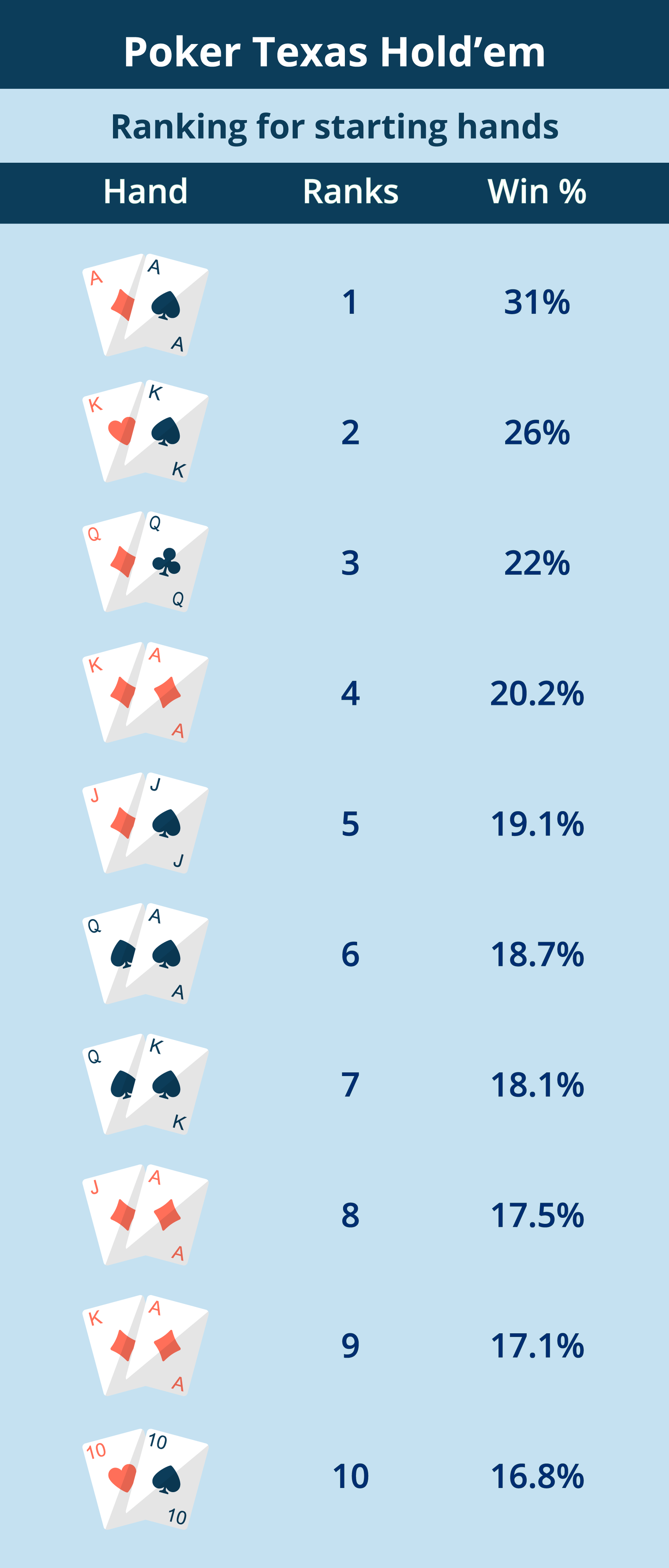Where to Play the Best Texas Hold’Em Poker Online?
There are many casinos where players can indulge in long and rewarding Texas Hold’em Poker sessions. Our list consists of the best poker sites with generous bonuses.
| Casino | Welcome Offer | |
|---|---|---|
| 9Winz | Bonus Up to 75,000 INR | Claim the Offer |
| Mostbet | New Player Bonus: Bonus Up To 25,000 INR + 250 Free Spins | Claim the Offer |
| Nomini | Bonus Up to 40,000 INR + 200 Free Spins | Claim the Offer |
Master the Rules & Odds of Texas Hold’Em
There are no special Texas Hold’Em poker rules. In this game, players receive two cards face-down – a “hand”. From here, they can either check, raise or call bets to progress the game.
Players can choose to bluff their way through, leading others to think they have a winning hand. There are also two forced bets per round – the big blind and the small blind.
The Texas Hold’Em poker odds allow players to know the probability of obtaining a specific hand. From the worst to best hand, the chances are as follows:
- High Card – 50.11%
- One Pair – 42.26%
- Two Pair – 4.75%
- Three of a Kind – 2.11%
- Straight – 0.39%
- Flush – 0.20%
- Full House – 0.14%
- Poker – 0.024%
- Straight Flush – 0.0014%
- Royal Flush – 0.00015%

The Objective
Ultimately, the goal of Texas Hold’Em poker is to create the best five-card combination using your hand and community cards. Players can win in two ways: 1) Have the best combination or 2) Make other players fold.
Types of Bets in Texas Hold’Em
Here, you’ll learn everything about Texas Hold ’em poker bets. Generally, the game has five types of bets players can make. Take a look:
Blinds
Blinds are a forced bet the first two players on the left of the dealer button must make. The value of these bets is usually defined before the game starts. There are two types of blinds:
- Small Blind – The lowest bet, typically equal to the minimum table bet. It’s made by the first player after the dealer button.
- Big Blind – The second player after the button must place this bet. Its value is at least twice the small blind.
Call
A call is a bet player can perform when they want to match an opposing bet.
Check
Players can check when they don’t have a bet to match. When a check is made, no wagers are placed. Players can only check if no bets were made that round.
Raise
Players should raise when they want to increase their bet past their opponent’s.
All In
When a player bets all of his stack, ending up with no chips left.
Special Bets
Besides the usual bets, players can make several other special bets. While they’re based on the basic five bet types, their names differ depending on the game’s condition. These include:
- Overbet – An aggressive bet where players wager more than they need to.
- Underbet – The opposite of an overbet.
- Value Bet – Betting the right amount for the hand a player has.
- Re-Raise – When two or more raises happen in succession.
- Pot Bet – When a player places a bet equal to the pot size.
Although these are the common Texas Hold’Em poker bets, players can place several other special wagers.
RTP, Payouts and House Edge in Texas Hold’Em
Playing Texas Hold ’em poker online is a different experience from any other casino game. While most casino games are described in terms of their RTP, payouts, and house edge, Texas Hold ’em poker doesn’t abide by these rules.
Here’s our take on how these terms apply to Texas Hold’Em poker:
RTP in Texas Hold’Em
RTP, or Return to Player, is a percentage that represents the average return after a given number of plays in a casino game.
When you play Texas Hold’Em poker, online or offline, there is no way to calculate the RTP percentage since you’re not playing against the house.
Payouts in Texas Hold’Em
The Texas Hold’Em poker payouts depend on the pot itself. No matter how good your card combination is, you can only win what’s in the pot. Therefore, there isn’t a payout table for Texas Hold’Em poker.
House Edge in Texas Hold’Em
As we’ve mentioned, the house isn’t part of Texas Hold’Em poker games. This means the house edge is nonexistent, as players are going against each other.
However, some poker variations such as 3-Card Poker or Ultimate Texas Hold ’em Poker let players face the dealer.
Texas Hold’Em vs Other Poker Variants
It’s only expected that such a highly popular game like Texas Hold’Em poker features many variations. The differences are usually related to the highest hands, and combinations players can make.
Have a look at the most common types of poker and their main differences:
| Texas Hold’Em | Omaha | 7-Card Stud | 3-Card Poker | Ultimate Texas Hold’Em Poker | |
|---|---|---|---|---|---|
Hand | 2 Cards | 4 Cards | 3 Cards (2 Face Down, 1 Face Up) | 3 Cards | 2 Cards |
| Bets | Normal | Normal | Normal | Ante, Pair Plus, Play | Normal, Ante, Trips |
| RTP | N/A | N/A | N/A | 96.63% | 97.81% |
| House edge | N/A | N/A | N/A | 2.32% to 3.37% | 2.19% |
Difference Between Texas Hold’Em and Omaha Poker
Omaha Poker is one of the most popular variants of the classic card game. In this variant, players receive four cards instead of two. They must then choose exactly two cards to create their five-card combinations.
Difference Between Texas Hold’Em and 7-Card Stud Poker
In this variant, players are given seven cards, four face up and two faces down. They must pick five out of seven cards in the showdown to create their combination.
Difference Between Texas Hold’Em and 3-Card Poker
3-Card Poker is the simplest variant of the game. Players can perform three actions after receiving three cards – Ante, a type of forced bet; Pair Plus, betting they’ll have a pair or better; or Play, pitting their hand versus the dealers.
Difference Between Texas Hold’Em and Ultimate Texas Hold’Em Poker
While this variant allows players to beat the dealer, the main differences are the Ultimate Texas Hold’Em poker bets. Players can either place an Ante bet to enter the round or bet on “Trips“, meaning they’re confident they’ll get a three-of-a-kind or better.
It features one of the most complex Texas Hold’Em poker rules.
Strategies for Advanced Players
The basic poker strategy is enough for most players. However, if you’re looking to up your game, you might want to take a look at an advanced Texas Hold’Em poker strategy. Here are the most critical advanced techniques for Texas Hold’Em poker:
Bluffing
This strategy is all about lying. The goal of bluffing is to make your opponents think you have a good hand. To do this, players should play aggressively, raising their bets.
In the showdown, players can choose to show their bluffs. This adds a whole new layer of depth, triggering opponents into further bad calls.
Hand Reading
Hand reading is essentially determining the range of hands an opponent could have. While it doesn’t fully predict the outcome, it allows players to narrow down the possibilities. From here, players can act accordingly.
Game Theory Optimal (GTO)
GTO is often regarded as the perfect Texas Hold’Em poker strategy. When playing with this strategy, players are essentially making themselves unexploitable. Therefore, GTO is more of a defensive system.
Many professional players use GTO-based hybrid strategies to exploit their opponents further.
Tells
Tells are small actions the most experienced players watch out for during Texas Hold’Em poker. In this strategy, players must pay attention to their opponents at all times, picking up cues that might show them their intentions.
How to Play Texas Hold’Em – Breakdown of a Round
Every Texas Hold’Em poker round is divided into a maximum of six different phases. Let’s get into the details of every stage:
- Blinds – The small blind and big blind players place their bets.
- Pre-Flop – Players are given two cards each, followed by a betting round.
- Flop – The dealer burns a card and places three cards face-up on the table, followed by a round of betting.
- Turn – A fourth card is dealt face-up on the table. Players can bet again.
- River – The fifth and final card is shown, allowing players to bet again.
- Showdown – If two more players remain, they must show their cards to find out who’s the winner.
Easy Beginner Mistakes to Avoid
Unlike most casino games, Texas Hold’Em poker is a game of skill. Even though luck is involved, being lucky won’t take you far in the long run.
To master the game, you must have deep knowledge of poker strategy, psychology and game theory. This is often why mixed GTO-based strategies are often considered the best, as they take all these factors into account.
If you’re a poker beginner, here are some things you should avoid doing. Following these will likely increase your Texas Hold ’em poker payouts:
- Playing too many hands – Beginners often feel like they need to play every round. In reality, you should only take advantage of your best hands while folding the rest.
- Frequent bluffing – Bluffing should be unpredictable, which is why regularly doing so can be a risky play.
- Commit too much – Players shouldn’t get attached to hands, even if they’ve already bet too much. If you’re unsure what to do, fold.
- Chasing pots – Many players hold until the showdown to try and make a good combination. However, this doesn’t usually work. If you don’t have a good starting hand or flop, it’s best to give up.










